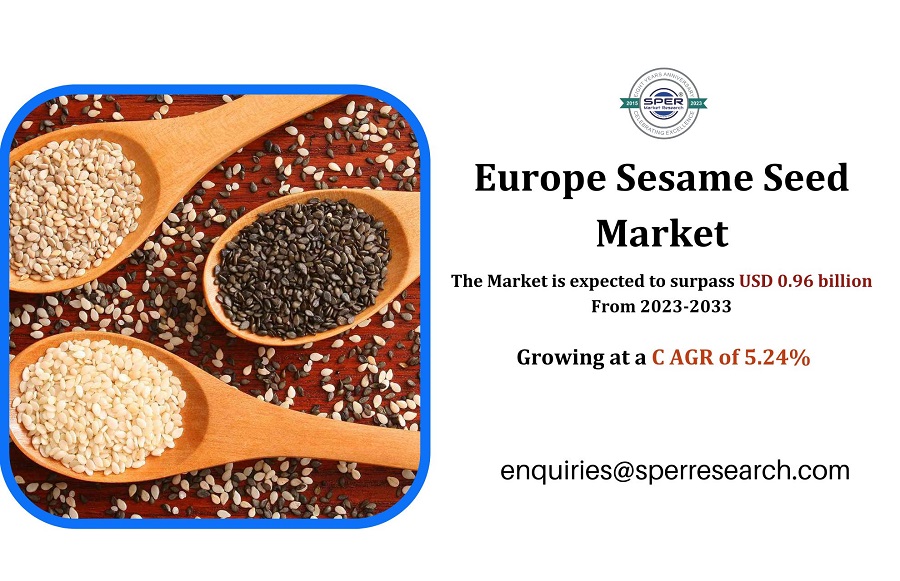Europe Sesame Seed Market Growth and Size, Rising Trends, Revenue, Industry Share, CAGR Status, Challenges, Future Opportunities and Forecast Analysis Till 2033: SPER Market Research

Sesame seeds are small, oil-rich seeds that are utilized extensively in the food preparation industry because of their flavour, oil content, and nutritive value. They are an excellent source of minerals including calcium, iron, and magnesium as well as fats that are beneficial and protein. Numerous goods, including tahini, halva, sesame oil, and sesame treats, are made from sesame seeds. The oil that is derived from sesame seeds is widely used in cosmetics and to extend the shelf life of packaged foods. Consumers are choosing organic sesame seeds with increasing frequency for their pure and unadulterated character, which reduces the health concerns linked with consuming synthetic products.
According to SPER Market Research, ‘Europe Sesame Seed Market Size- By Source, By Application, By Color- Regional Outlook, Competitive Strategies and Segment Forecast to 2033’ state that the Europe Sesame Seed Market is estimated to reach USD 0.96 billion by 2033 with a CAGR of 5.24%.
The factors driving the market include the increasing demand for sesame seed as a functional ingredient in various meals due to its benefits such as lowering blood pressure, aiding in digestion as well as having a wealth of vitamins, minerals, polyphenols, and antioxidants. The market is driven by customer preferences for organically sourced, health-based, and functional items. In the near future, the market for sesame seeds is anticipated to be driven by the increasing use of sesame seeds as an antioxidant source in a variety of medicinal formulations.
The European market is diverse with differences in national culinary customs and customer preferences. The sesame seed market is highly dependent on imports, which makes it vulnerable to supply chain disruptions. A number of factors, including weather, crop yield, and geopolitical tensions, can affect the price of sesame seeds. Chia seeds, flaxseeds, and other substitute products are competitors of sesame seeds that might restrain the growth of sesame seed market in Europe. The European market is also heavily regulated and the supply chain for sesame seeds is made more difficult and expensive by the need to adhere to strict requirements for food safety and quality.
Request For Free Sample Report @ https://www.sperresearch.com/report-store/europe-sesame-seed-market.aspx?sample=1
The market for sesame seeds in Europe has been severely affected by the COVID-19 outbreak. Due to the pandemic’s disruption of international supply networks, there have been shortages and price swings. Additionally, the short-term demand for items based on sesame has decreased due to the closure of restaurants and food service facilities. The epidemic has pushed forward the adoption of electronic commerce platforms, supplying novel opportunities for revenue generation for industry players. Due to rising demand for nutritional and environmentally sound food items, the pandemic is predicted to have a favourable long-term effect on the sesame seed industry.
Turkey is the country with the largest sesame seed market as sesame is an essential component of Turkish diet and is used to prepare a variety of Turkish meals. However, due to increased seed prices, a reduction in sesame seed consumption is anticipated in the next years. Greece is projected to capture a substantial portion of the European market since the country utilizes a lot of sesame, which is an essential component in many traditional Greek. Some of the key market players are Sesaco Corporation, Dipasa Europe B.V., Selet Hulling PLC., Archer Daniels Midland Company, Bunge Ltd.
For More Information, refer to below link:-
Europe Sesame Seed Market Outlook
Related Reports:
Follow Us –
LinkedIn | Instagram | Facebook | Twitter
Contact Us:
Sara Lopes, Business Consultant – USA
SPER Market Research
+1–347–460–2899





